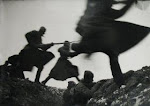Nantucket sure makes it difficult to arrive and leave. Nicknamed 'The Grey Lady', we experienced first hand why she carries this name so proudly. After 3 flight cancellations between arriving and departing, the perils of weather including fog, thunderstorms and side effects of the Caribbean hurricanes were made clear. No wonder the island is secluded. Once you get there, this fine lady wraps you in her grey cloak every night and early morning so you have no chance of leaving!
It made me think of those poor Nantucket whalers who sailed the seas for months only to try and return to their beloveds and get lost in the mists that roll over the Atlantic and hide forever this tiny isle. The Native Indians must have been so distraught when the first white man actually landed on their blessed shores. They probably thought they were shielded from history forever.
This happened in 1602 to be exact, In fact, apparently it was way back in the 11th century that the Norsemen actually sighted Nantucket - must have been a fair weather day - but it was English Captain Batholomew who put the island on the map so to speak in 1602. The next few decades are reminiscent of so many other parts of the US. The Indians greet the white man warmly, then get done over by being tricked into selling their land for pennies. Then for the next decade they are decimated through white man's diseases, alcohol addiction and debt servitude.
Fast forward to the 1750's through 1850's and Nantucket has become the whaling centre of the world. Long before white man arrived, the Indians actually used to salvage dead whales that drifted ashore - they probably got lost in the dreaded fog as well - and recognized the value of the meat and oil they extracted. The white settlers used to hunt the right whales close to shore, but it was when a boat was blown out to sea in 1812 that the famed sperm whale was discovered. These whales were custodians of the finest oil available, called 'spermaceti' which was stored in their massive head. This oil was prized for use in candles, and lighting in the lighthouses and lamps on the island and around the world.
And so the age of Nantucket's greatest prosperity began, as did the wonderful tales of whalers and their prey. Herman Melville based his seminal book
Moby Dick on the true story of the Nantucket ship
Essex that was rammed by a sperm whale and only half the crew survived washed up on a deserted island.
But of course, all good things must come to an end. This end resulted in the discovery of petroleum in 1838. Lucky for the whales, unlucky for Nantucket. Then came the Civil War, then a massive fire all leading to a long period of stagnation.
Today, Nantucket boasts a very healthy tourist trade as well as a decent number of avid islanders who live there all year long. And it has so much to offer. From the wonderful whaling captains' houses in town to the rolling salt marshes and moors. There's a bounty of native fruit - beach plums, rose hips and cranberries - and miles of coastline. There's lighthouses for the kids, boats for the men, shopping for the women and historical museums for the whole family. But best of all, there is peace, nature, the strong smell of salt air, the sound of crashing waves, and bike paths through hundreds of acres of untouched land. At times I felt like I was back in the original of the Wampanoags. Keep that grey mist surrounding this treasured place.






























































































